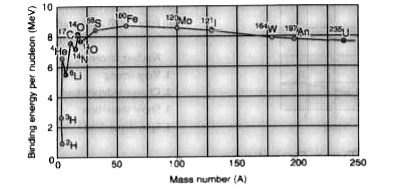Draw a plot of BE/A versus mass number A for . Use this graph to explain the release of energy in the process of nuclear fusion of two light nuclei.
OR
Using the curve for the binding energy per nucleon as a function of mass number A, state clearly how the release in energy in the processes of nuclear fission and nuclear fusion can be explained.
OR
Draw a plot of the binding energy per nucleon as a function of mass number for a large number of nuclei, . How do you explain the constancy of binding energy per nucleon in the range using the property that nuclear force is short-ranged ? Solution in Kannada

The above curve shows that
(i) When a heavy nucleus breaks into two medium sized nuclei (in nuclear fission) the BF/nucleon increases resulting in the release of energy.
(ii) When two small nuclei combine to form a relatively bigger nucleus in nuclear fusion BF/nucleon increases, resulting in the release of energy.
OR
The constancy of the binding energy in the range is a consequence of the fact that the nuclear force is short-ranged. If a nucleon can have a maximum of neighbours within the range of nuclear force, its binding energy would be proportional top. If we increase A by adding nucleons they will not change the binding energy of a nucleon inside. Since most of the nucleons in a large nucleus reside inside it and not on the surface, the change in binding energy per nucleon would be small. Hence the binding energy per nucleon is a constant, (saturation property of nuclear forced.)
Topper's Solved these Questions
- BOOK - OSWAAL PUBLICATIONCHAPTER - NUCLEIEXERCISE - TOPIC -2 (Short Answer Type Questions-II)2videos
NUCLEI
- BOOK - OSWAAL PUBLICATIONCHAPTER - NUCLEIEXERCISE - TOPIC -2 (Long Answer Type Questions)2videos
NUCLEI
- BOOK - OSWAAL PUBLICATIONCHAPTER - NUCLEIEXERCISE - TOPIC -2 (Very Short Answer Type Questions)5videos
NUCLEI
- BOOK - OSWAAL PUBLICATIONCHAPTER - MOVING CHARGES & MAGNETISMEXERCISE - TOPIC-3 (Current Carrying Conductor & Galvanometer) (Numerical Problem)1videos
MOVING CHARGES & MAGNETISM
- BOOK - OSWAAL PUBLICATIONCHAPTER - RAY OPTICS AND OPTICAL INSTRUMENTSEXERCISE - TOPIC-3(Numerical Problems)3videos
RAY OPTICS AND OPTICAL INSTRUMENTS
Similar Questions
Define the terms (i) mass defect, (ii) binding energy for a nucleus and state the relation between the two.
For a given nuclear reaction, the B.E./nucleon of the product nucleus/nuclei is more than that for the original nucleus/nuclei. Is this nuclear reaction exothermic or endothermic in nature? Justify your choice.03:35View SolutionDistinguish between nuclear fission and nuclear fusion.
01:32View SolutionWhat is meant by specific binding energy ?
01:36View SolutionAn ammeter of resistance 0.80Ω can measure current upto 1.0 A.
(i) What must be the value of shunt resistance to enable the ammeter to measure current upto 5.0 A ?
(ii) What is the combined resistance of the ammeter and the shunt ?06:31View SolutionThe total magnification produced by a compound microscope is 20. The magnification produced by the eye piece is 5. The microscope is focussed on a certain object. The distance between the objective and eyepiece is observed to be 14cm.
If the least distance of distinct vision is 20cm, calculate the focal length of the objective and the eye piece.View SolutionAssertion: The nuclear energy can be obtained by the nuclear fission of heavier nuclei as well as by fusion of lighter nuclei. Reason: As the mass number increases, the binding energy per nucleon, first increases and then decreases.
View SolutionDraw a plot of the binding energy per nucleon as a function of mass number for a large number of nuclei , 2 le A le 240 . How do you explain the constancy of binding energy per nucleon in the range 30 lt A lt 170 using the property that nuclear force is short-ranged ?
14:58View Solutionयदि एक नाभिकीय सुलयन प्रक्रिया में द्रव्यमान - क्षति 0.3 % हो तो । किग्रा द्रव्यमान की नाभिकीय संलयन प्रक्रिया में कितनी ऊर्जा मुक्त होगी ?
03:06View Solutionप्रति न्यूक्लिऑन बंधन ऊर्जा का द्रव्यमान संख्या A के साथ परिवर्तन दर्शाता हुआ ग्राम बनाएँ । इस ग्राफ़ से निकाले जा सकने वाले दो महत्वपूर्ण निष्कर्ष लिखें। इस ग्राफ की सहायता से नाभिकीय विखंडन संलयन की प्रक्रिया में ऊर्जा मोचन की व्याख्या करें।
11:26View Solutionद्रव्यमान संख्या के साथ प्रति न्यूक्लिऑन बंधन ऊर्जा में परिवर्तन को प्रदर्शित करने वाले ग्राफ का उपयोग करते हुए स्पष्ट कीजिए कि नाभिकीय विखंडन और नाभिकीय संलयन में ऊर्जा मुक्त होने की प्रक्रिया की व्याख्या किस प्रकार की जा सकती है।
View SolutionUse this graph to explain the release of energy in both the processes of nuclear fusion and fission
View SolutionVARIATION OF BINDING ENERGY OF PER NUCLEON WITH MASS NUMBER
03:06View SolutionNuclear energy is released in fusion reaction, since binding energy per nucleon is
04:21View SolutionExplain the process of nuclear fission and nuclear fussion by using the plot of binding energy per nucleon (BE/A) versus the mass number A .
View SolutionUsing the curve for the binding energy per nucleon as a function of mass number A, state clearly how the release in energy in the processes of nuclear fission and nuclear fusion can be explained.
03:07View Solution

